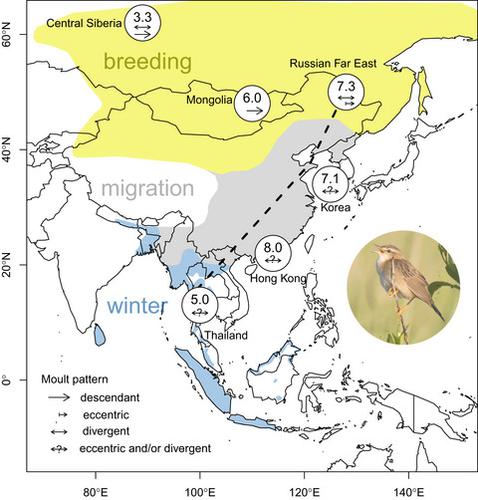当前位置:
X-MOL 学术
›
Ecol. Evol.
›
论文详情
Our official English website, www.x-mol.net, welcomes your feedback! (Note: you will need to create a separate account there.)
Complex postbreeding molt strategies in a songbird migrating along the East Asian Flyway, the Pallas’s Grasshopper Warbler Locustella certhiola
Ecology and Evolution ( IF 2.6 ) Pub Date : 2020-12-21 , DOI: 10.1002/ece3.7098 Hans‐Jürgen Eilts 1 , Nele Feuerbach 1 , Philip D. Round 2 , Oleg Bourski 3 , John Allcock 4 , Paul Leader 5 , Batmunkh Davaasuren 6 , Tuvshinjargal Erdenechimeg 6 , Jong‐Gil Park 7 , Wieland Heim 8
Ecology and Evolution ( IF 2.6 ) Pub Date : 2020-12-21 , DOI: 10.1002/ece3.7098 Hans‐Jürgen Eilts 1 , Nele Feuerbach 1 , Philip D. Round 2 , Oleg Bourski 3 , John Allcock 4 , Paul Leader 5 , Batmunkh Davaasuren 6 , Tuvshinjargal Erdenechimeg 6 , Jong‐Gil Park 7 , Wieland Heim 8
Affiliation

|
Molt strategies have received relatively little attention in current ornithology, and knowledge concerning the evolution, variability and extent of molt is sparse in many bird species. This is especially true for East Asian Locustella species where assumptions on molt patterns are based on incomplete information. We provide evidence indicating a complex postbreeding molt strategy and variable molt extent among the Pallas's Grasshopper Warbler Locustella certhiola, based on data from six ringing sites situated along its flyway from the breeding grounds to the wintering areas. Detailed study revealed for the first time that in most individuals wing feather molt proceeds from the center both toward the body and the wing‐tip, a molt pattern known as divergent molt (which is rare among Palearctic passerines). In the Russian Far East, where both breeding birds and passage migrants occur, a third of the adult birds were molting in late summer. In Central Siberia, at the northwestern limit of its distribution, adult individuals commenced their primary molt partly divergently and partly with unknown sequence. During migration in Mongolia, only descendantly (i.e., from the body toward the wing‐tip) molting birds were observed, while further south in Korea, Hong Kong, and Thailand the proportion of potential eccentric and divergent feather renewal was not identifiable since the renewed feathers were already fully grown as expected. We found an increase in the mean number of molted primaries during the progress of the autumn migration. Moderate body mass levels and low‐fat and muscle scores were observed in molting adult birds, without any remarkable increase in the later season. According to optimality models, we suggest that an extremely short season of high food abundance in tall grass habitats and a largely overland route allow autumn migration with low fuel loads combined with molt migration in at least a part of the population. This study highlights the importance of further studying molt strategy as well as stopover behavior decisions and the trade‐offs among migratory birds that are now facing a panoply of anthropogenic threats along their flyways.
更新日期:2021-01-08



























 京公网安备 11010802027423号
京公网安备 11010802027423号